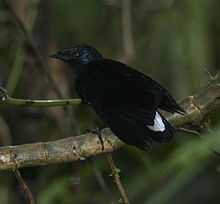Silktail
| Silktail | |
|---|---|
 | |
| Conservation status | |
| Scientific classification | |
| Kingdom: | Animalia |
| Phylum: | Chordata |
| Class: | Aves |
| Order: | Passeriformes |
| Family: | see text |
| Genus: | Lamprolia Finsch, 1874 |
| Species: | L. victoriae |
| Binomial name | |
| Lamprolia victoriae Finsch, 1874 | |
The Silktail (Lamprolia victoriae) is a species of bird endemic to Fiji. It is the only member of the genus Lamprolia. This beautiful bird looks superficially like a diminutive bird of paradise but it is actually closely related to the fantails.
Taxonomy and systematics
The systematic position of the Silktail has been a long-standing mystery.[2] When describing the species Otto Finsch wrote "I scarcely remember a bird which has puzzled me in respect of its generic position so much as this curious little creature".[3] It has variously been placed with the birds-of-paradise (Paradisaeidae), the Australasian robins (Petroicidae) and the fairy-wrens (Maluridae). Since 1980 it has generally been considered to be an ancient and aberrant monarch flycatcher.[4] A 2009 molecular study placed the species as a sister to the Pygmy Drongo of the highlands of New Guinea, and the two of these as a sister clade to the fantails (Rhipiduridae).[5]
The genus Lamprolia is named after the diminutive of lampros (Ancient Greek) for splendid or brilliant.[6] Finsch named the species after Victoria, eldest daughter of Queen Victoria, who was then Crown Princess of Germany. The subspecies L. v. kleinschmidti is named for Theodor Kleinschmidt, a collector from Museum Godeffroy in Hamburg, who obtained the first specimens.[2]
Description
The Silktail is a small black bird, measuring around 12 centimetres (4.7 in) and weighing 16–21 g (0.56–0.74 oz). It is a small, dumpy bird with long rounded wings, and a short rounded tail. The plumage of the male is velvet black with metallic blue iridescent spangling on the crown and breast, and silky white lower-back patch that travels most of the length down the tail. The margin of the tail is black, sometimes this tip has the same iridescence as other parts of the body. The female is similar to the male, except less glossy, and immature birds are duller than the adults and may have buffy rumps and backs. The irises of this species are dark, and the legs and bill are blackish.[7] The bill is heavy and slightly hooked at the end. The legs are long and the feet strong.[2] The subspecies L. v. kleinschmidti is smaller than the nominate race and has more iridescence plumage than the nominate.[7]
Distribution and habitat
The Silktail is endemic to forests of Taveuni and Vanua Levu in Fiji. It occurs widely on Taveuni, but has a more restricted distribution on Vanua Levu, where it only occurs in the east of the island on the Natewa Peninsula. It occurs in mature wet rainforests, as well as forest patches, and is also found in human-modified habitats such as logged forests and in plantations near patches of natural forest.[7]
Behaviour
The Silktail can be quite elusive and difficult to see, but may also be confiding and approachable. It is usually very active at dawn, and is encountered either singily or in small flocks.
The diet consists mainly of insects, worms and arthropods.
Status and conservation

The Silktail is a restricted range species, being present only on two islands in Fiji. It is absent from apparently suitable habitat on Vanua Levu, where it only occurs on the Natewa Peninsula. It is more widespread on Taveuni. Forest clearance for mahogany plantations and general forest clearance within its range have led to the species being listed as vulnerable in 1994, however this was downgraded to near threatened in 2006. While its habitat is being lost, it is not yet severely fragmented. On Taveuni forest clearance is slower than Vanua Levu and the population is estimated to be around 5,000-8,000 pairs. The population in Vanua Levu is smaller, at around 3,000-6,000 pairs. A reserve for the species has been proposed on Vanua Leu, but has not yet been gazetted.[1] On the island of Taveuni the species occurs within the Ravilevu Nature Reserve and the Bouma National Heritage Park.[7]
References
- ↑ 1.0 1.1 BirdLife International (2012). "Lamprolia victoriae". IUCN Red List of Threatened Species. Version 2013.2. International Union for Conservation of Nature. Retrieved 26 November 2013.
- ↑ 2.0 2.1 2.2 Cottrell, G.W. (1966). "A problem species: Lamprolia victoriae.". Emu 66 (3): 253–266. doi:10.1071/MU966253.
- ↑ Finsch, Otto (1873). "On Lamprolia victoriae, a most remarkable Passerine Bird from the Feejee Islands". Proceed. of the Zool. Society of London Pt. 3: 733–735.
- ↑ Storrs, Olson (1980). "Lamprolia as part of a South Pacific radiation of monarchine flycatchers.". Notornis 27 (1): 7–10.
- ↑ Irested, Martin; Fuchs J; Jønsson KA; Ohlson JI; Pasquet E & Per G.P. Ericson (2009). "The systematic affinity of the enigmatic Lamprolia victoriae (Aves: Passeriformes)—An example of avian dispersal between New Guinea and Fiji over Miocene intermittent land bridges?". Molecular Phylogenetics and Evolution 48 (3): 1218–1222. doi:10.1016/j.ympev.2008.05.038. PMID 18620871.
- ↑ Jobling, James A. (1991). A Dictionary of Scientific Bird Names. Oxford: Oxford University Press. p. 125. ISBN 0-19-854634-3.
- ↑ 7.0 7.1 7.2 7.3 Coates, Brian; Dutson, Guy; Filardi, Chris; Clement, Peter; Gregory, Phil; Moeliker, Kees (2007). "Family Monarchidae (Monarch-flycatchers)". In Josep, del Hoyo; Andrew, Elliott; David, Christie. Handbook of the Birds of the World. Volume 11, Old World Flycatchers to Old World Warblers. Barcelona: Lynx Edicions. p. 322. ISBN 84-96553-06-X
| Wikimedia Commons has media related to Lamprolia victoriae. |
| Wikispecies has information related to: Lamprolia victoriae |
